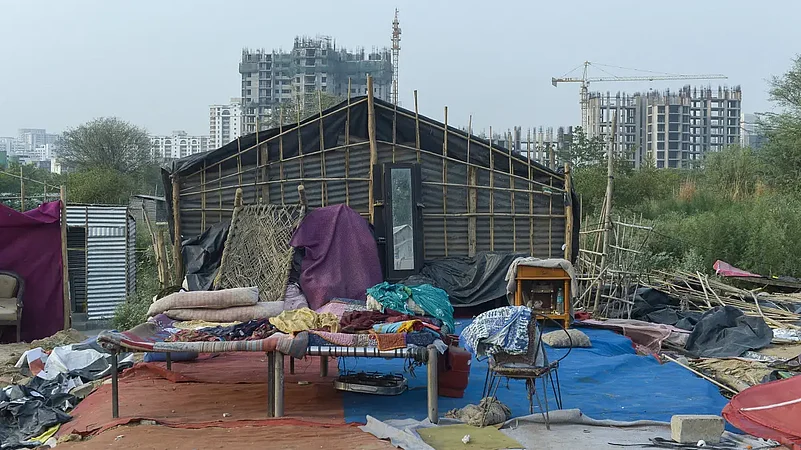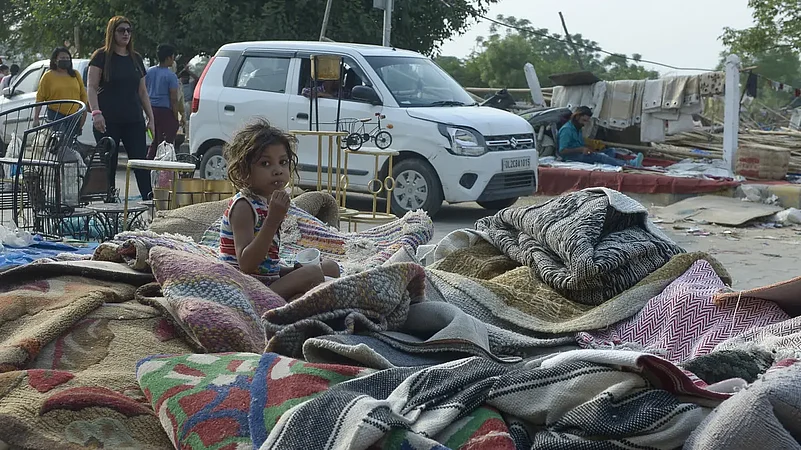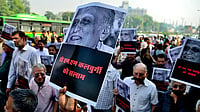On May 5, Shamsher Sheikh, a student of class III in Gurugram’s Gurukool school, rushed home well before school’s closing time. While rice in a half-covered utensil boiled on a fire-wood chullah outside the shanty, the young boy stoically watched his defenceless parents emptying their small bamboo and tin house. That morning, a loudspeaker, fitted atop an auto-rickshaw, had blared out the following warning for slum-dwellers at Saraswati Kunj: “Jhuggi-jhonpris (slums) have been set up on the government land. Vacate them. You have time to remove the belongings by 5 pm. Thereafter, we are going to run the JCBs.”
After the famed Banjara market, a makeshift handicraft market at sector 56 of the Gurugram, was reduced to rubble last week, a massive demolition drive is currently underway at the adjoining Saraswati Kunj to clear a vast expanse of congested slums spread over several kilometres amid high-rise buildings.
Even after losing their shanties and shops, the vendors at Banjara market haven’t left the place. In the past few days, their families have braved the scorching sun and the rain under the open sky. Claiming themselves to be members of a nomadic blacksmith community, they maintain that they abandoned their traditional occupation over two decades ago after the reliance on agricultural implements started to dwindle. On May 5, Thursday, the market represented a picture of devastation and desolation. But it was a day as usual for the shoppers for whom the marketplace has been a popular haunt for cheap home decors and handicraft wares for the last 15 years.

Even though the authorities had served eviction notices to the vendors last month, they stayed put for want of an alternative place to run their businesses and construct shelters. Last Tuesday, authorities bulldozed hundreds of shops and adjoining shanties to clear the area. The illegal market on the government land has seen several eviction drives in the past as well over complaints of traffic congestion.
“We decorate the houses of city residents. But see how they have ruined our houses and shops. We don’t demand concrete houses or big tracts of land. The government should settle us at a place where we could earn our livelihood peacefully. We will pay back to the government in instalments,” Sushila Lohar, 45, who would sell ceramic wares at the market, tells Outlook. Her shop and makeshift house were among hundreds of structures that were recently razed by Haryana Vikas Pradhikaran (HSVP), previously known as the Haryana Urban Development Authority (HUDA).
Sushila claims to be a descendant of Maharana Pratap, a 16th-century ruler of Mewar in Rajasthan who protected the region against repeated attacks from Mughals. “Please don’t treat us like insects,” she adds, requesting Haryana chief minister Manohar Lal Khattar and Prime Minister Narendra Modi to redress their issues compassionately. “Our life has been spoiled. We don’t want our children to meet the same fate.” While nodding in agreement, the distraught vendors sitting around her deplore that neither any political leader nor any social worker had visited them after the demolition of their homes and shops.
On the other side, the Saraswati Kunj slum settlement has been a home to several migrants working as domestic workers, construction workers, rickshaw drivers, security guards and menial day job labourers. Driven out of their villages by poverty, illiteracy and inequality, these migrant workers came to the city in search of job opportunities, dreaming of a better life. But the latest aggressive eviction drive has left them destitute and homeless, exposing the government’s failure to provide affordable housing facilities to allegedly underpaid migrant workers engaged in the informal sector.
On Thursday, the bulldozers smashed shanties in the area amid heavy police presence. An official of the Department of Town and Country Planning Enforcement, who was present on the spot, told Outlook that as many as 15,000 illegal structures in and around the area would be cleared. The tract of land where the slums have cropped up over the years has been caught in a legal tangle since 2004 over shady allotment of plots by a cooperative society. In spite of a construction ban imposed by the Punjab and Haryana High Court, several alleged plot owners have been instrumental in the construction of shanties and they have reportedly been charging rent from the slum dwellers.
Almost four years ago, Bulu Bibi, 36, came to the slum along with her husband, Shah Alam Sheikh, who has been incapacitated by a heart ailment. The couple had sold off a piece of their land at Noapara in West Bengal and spent that money here for setting up 53 shanties. The couple would get a rent of Rs 1600 from each tenant. “For each rented shanty, we used to give Rs 1200 to the plot owner who would ensure electricity and water supply,” she tells Outlook, but refuses to reveal her benefactor’s identity fearing repercussions.
Many slum dwellers link the demolition drive with the politics of optics around machines and JCBs, which have of late gained currency in some BJP-ruled states. “With the use of bulldozers, every chief minister wants to appear stronger than the other. Media too has encouraged them,” Rajesh Jaiswal, 28, who is a housekeeping staffer in a nearby apartment society. His wife, Purnima, 36, works as a domestic helper in the same building. Jaiswal gets a monthly salary of Rs 16,000 whereas his wife barely earns Rs 6,000 after working in four-five houses every month. They have a school going child who lives with his grandparents back home in Koyla Ghat in West Bengal’s South 24 Parganas district.
“We are left with no option but to shift to a proper rented accommodation in a residential area. It is going to cost us Rs 5,000 to 6,000 every month. Additionally, we will have to spend on rickshaw rides to work and back,” adds Jaiswal, wondering what would the couple save for their son’s higher education.

According to the couple, the slum area was home to thousands of migrant labourers from several other states such as Bihar, Jharkhand, Chhattisgarh, Madhya Pradesh and Orissa. While dumping his belongings in a mini-truck, Mohammad Gulab, a driver from Bihar, stresses, “The government should ensure that we too get affordable houses on rent or permanent basis.”
Salvaging material from the demolition site, a little distance away, a group of women refused to be photographed or identified. Angry over “insensitive” government action, one of them retorts, “You want to make everyone back home aware of our miserable condition. We are worse off now than we were before we came to the city.”
Having lost her home and most of her belongings, Jahana, 26, was sitting under the scorching sun, completely clueless about the future. She had a nine-month-old baby in her lap and a six-year-old daughter sitting by her side. Her husband abandoned her a few months ago and got remarried before she came here from Malda in West Bengal.
With nowhere to go in the absence of enough financial resources, many other slum dwellers were also struggling to come to terms with the devastation that was unfolding before their eyes. “We will live and die here,” Jaanu Rehman, 69, a cycle rickshaw puller, tells Outlook, with a lump in his throat and a sombre tremble in his voice. “No one is listening to us — whether it’s the police or the government officials!”


























